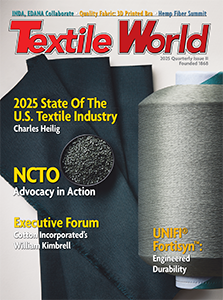ZÜRICH, Switzerland — April 13, 2017 — Switzerland’s textile machinery suppliers, organized by the national association Swissmem, held a two-day symposium in Cairo in early April. The objective was to strengthen the already well-established industrial ties between Egypt and Switzerland and to initiate a major step towards the revival of the Egyptian textile manufacturing sector.
Egyptian cotton is known worldwide for its quality and strength in applications such as shirts and bedsheets, its heritage dating back to the time of the Pharaohs. In the land of the Pyramids, the area around Giza also lends its name to some of the finest cotton varieties which are grown there.
Textile production, using both local and imported cotton, is a vital contributor to Egypt’s economy, ranking behind only tourism and Suez Canal revenues in the generation of income. But the textile sector’s performance and potential is being held back by financial constraints, rooted in the serious economic downturn of recent years and the accompanying severe devaluation of the Egyptian Pound.
Political instability since the revolution of 2011 drove away both tourists and overseas investors. And it has thus far hampered much-needed investment in new technology by the textile industry — so that its resurgence is now overdue.
Switzerland’s textile machinery suppliers, organised by the national association Swissmem, have now initiated a major step towards revival of Egyptian textile manufacturing, with a highly-successful two-day symposium held April 4-5, 2017, in Cairo. A total of 13 association member companies presented their latest machines and systems to an audience of 400, including representatives of the major textile producers from the private and public sectors, as well as delegates from various universities and research institutes.
As the first of the European textile machinery-producing countries to plan an event of this type, Switzerland recognizes the enormous potential for renewal of Egypt’s textile sector. The devaluations, while making Egyptian goods theoretically more attractive in export markets, have also seriously impacted on the cost and accessibility to Egypt’s textile companies of new production technology from the major producers.
The Swissmem symposium addressed this issue head-on, with direct offers of assistance in the key area of financing capital imports. Ernesto Maurer, Swissmem president, told the symposium: “Switzerland is ready to support Egypt in its striving to re-connect with the worldwide textile community.” He was referring to difficulties in accessing foreign exchange funds and the high costs associated with this, which have been a major obstacle to Egyptian companies seeking to renew their equipment and take up new technology.
“Funds need to be created prior to new investments, and here the Swiss textile machinery companies can help,” he said. “Sometimes, it is also the case that service and upgrade of existing equipment can be easier to achieve than complete renewal.”
Symposium participants heard a detailed explanation of export risk insurance and financing, presented by Fabian Brunschwiler, of SERV (Swiss Export Risk Insurance). His comments attracted significant attention, especially in relation to the assertion that Egypt was not yet making full use of the export finance facilities available from Switzerland.
Swiss textile machinery producers enjoyed strong export sales to Egypt in the years up to 2013, but the country’s economic and political woes since then have seen shipments decline to only 20% of previous levels. Now, as Egyptian textile manufacturers exhibit an eagerness to expand their markets, improve production capability and product quality, Swissmem is optimistic that it can offer both the financial and technological solutions they require.
Said Ernesto Maurer: “We are very confident that Egypt will find a way back to its previous position of strength, and its leading role in the world of high quality fabrics. The Egyptian cotton brand ‘Giza 100’ once stood as a synonym for quality in textile raw materials. Now, our Swiss textile machinery industry is an enthusiastic partner in facilitating and stimulating this revival.”
The 13 Swissmem companies taking part in the symposium were: Luwa, Amsler Tex, Heberlein, SSM Schärer Schweiter Mettler, Saurer (Embroidery), Rieter Components (Bräcker, Graf, Nobibra and Süssen), Stäubli, Jakob Müller, Retech, Loepfe, Maag, Benninger, and Santex-Rimar.
Posted April 13, 2017
Source: Swissmem




